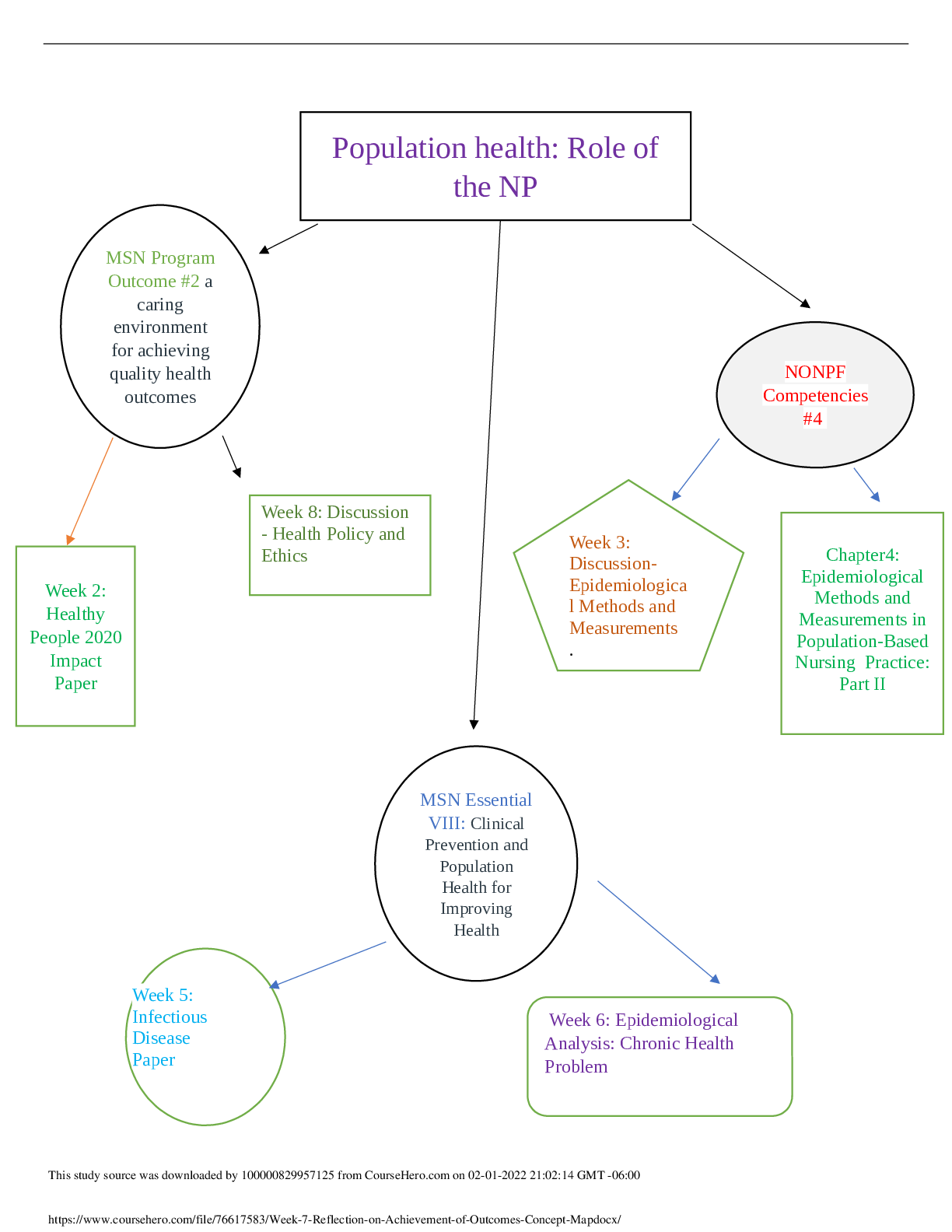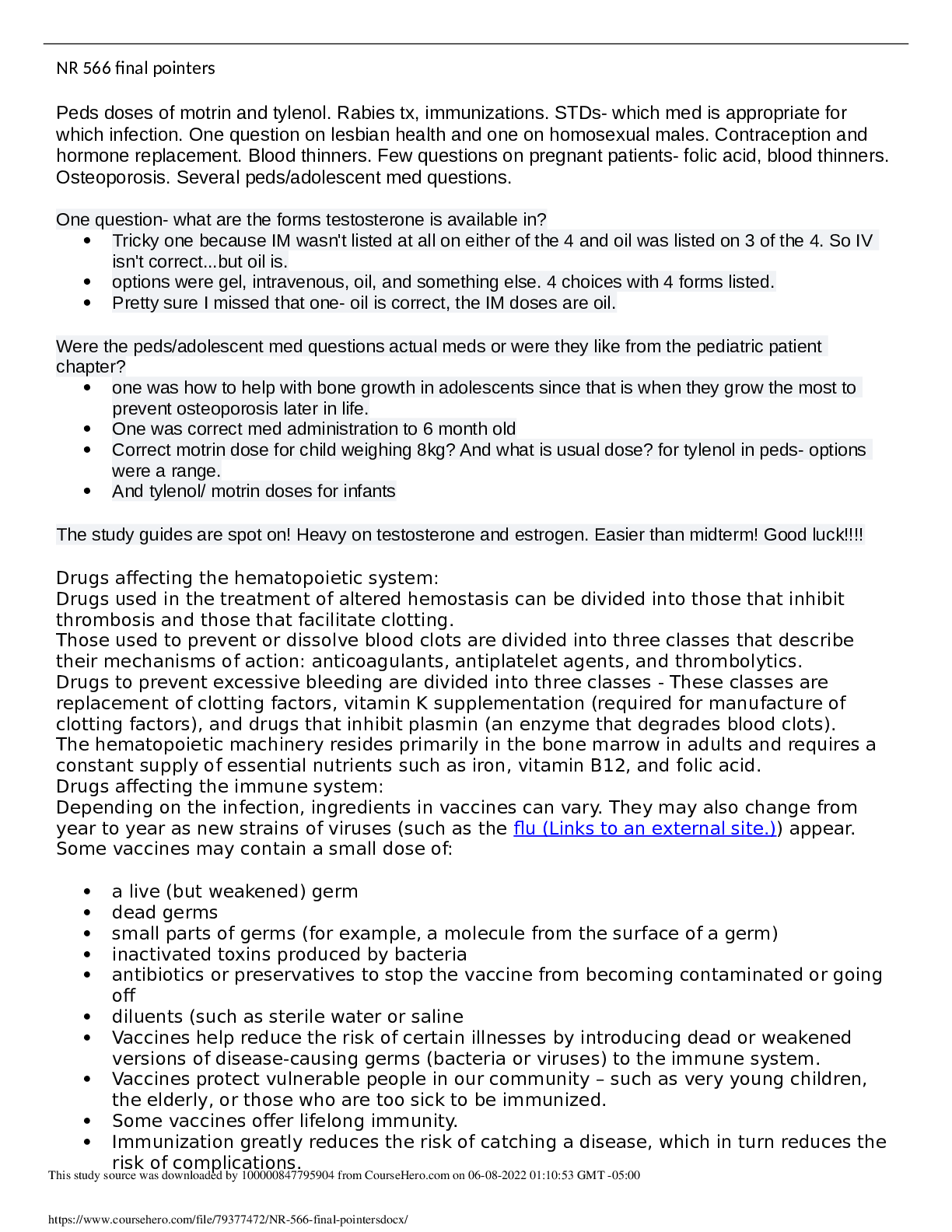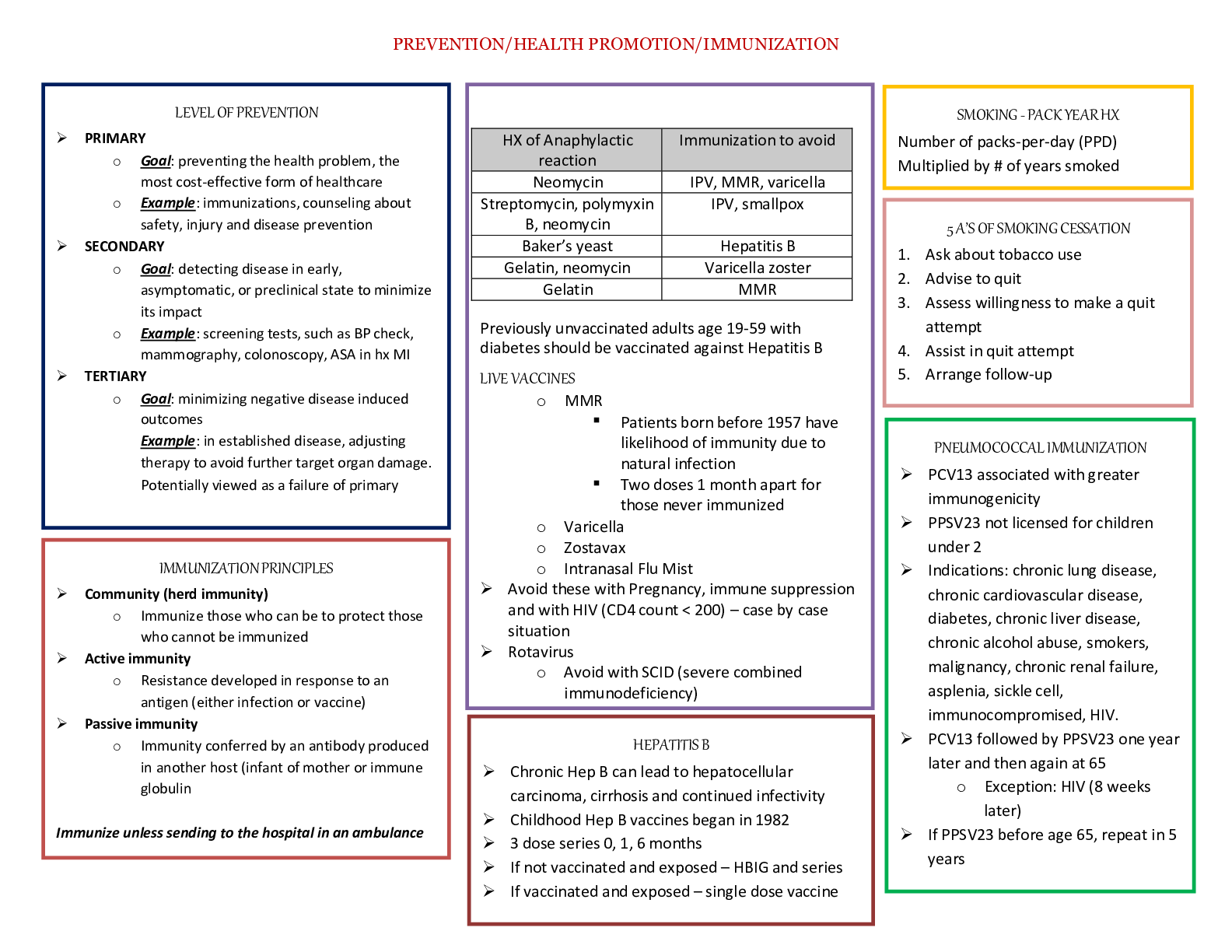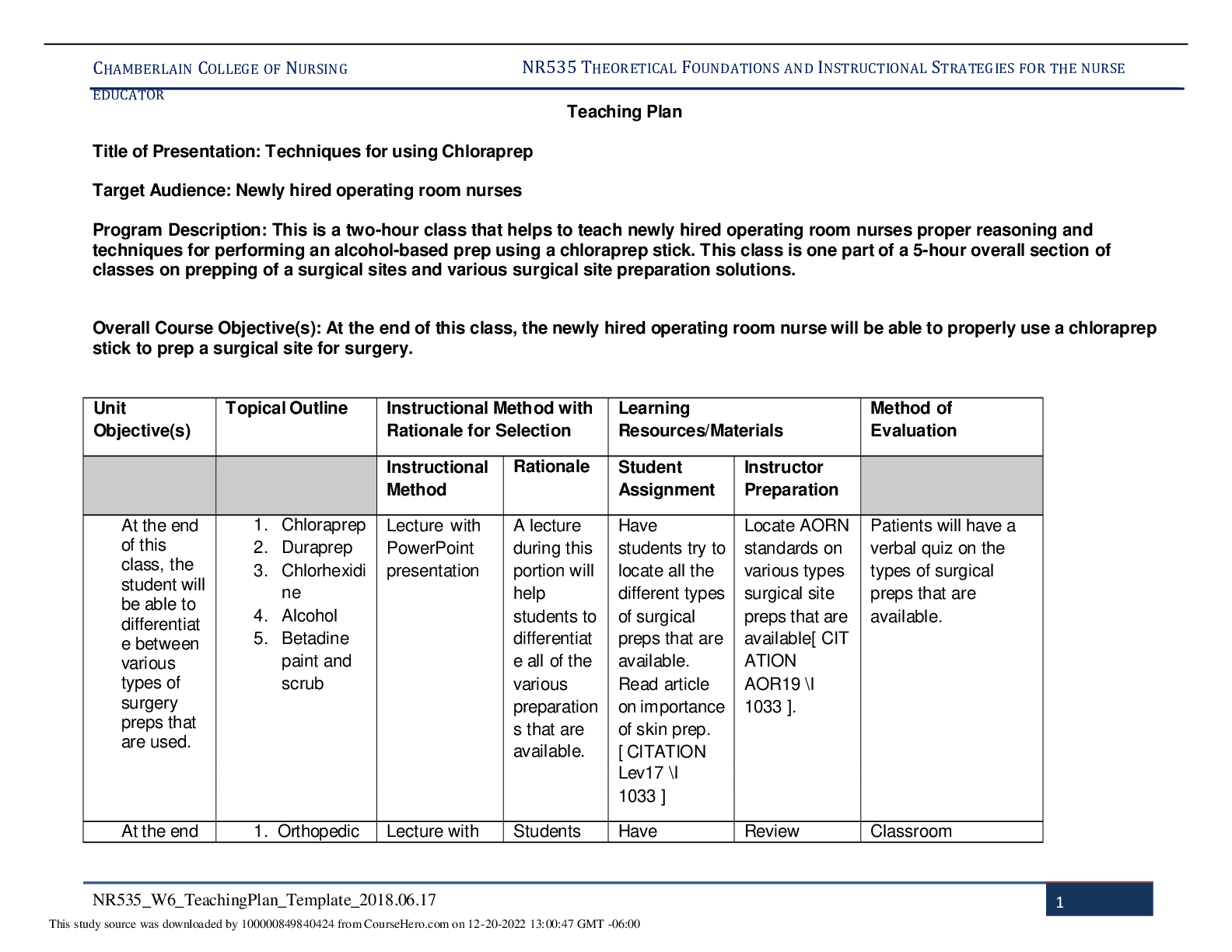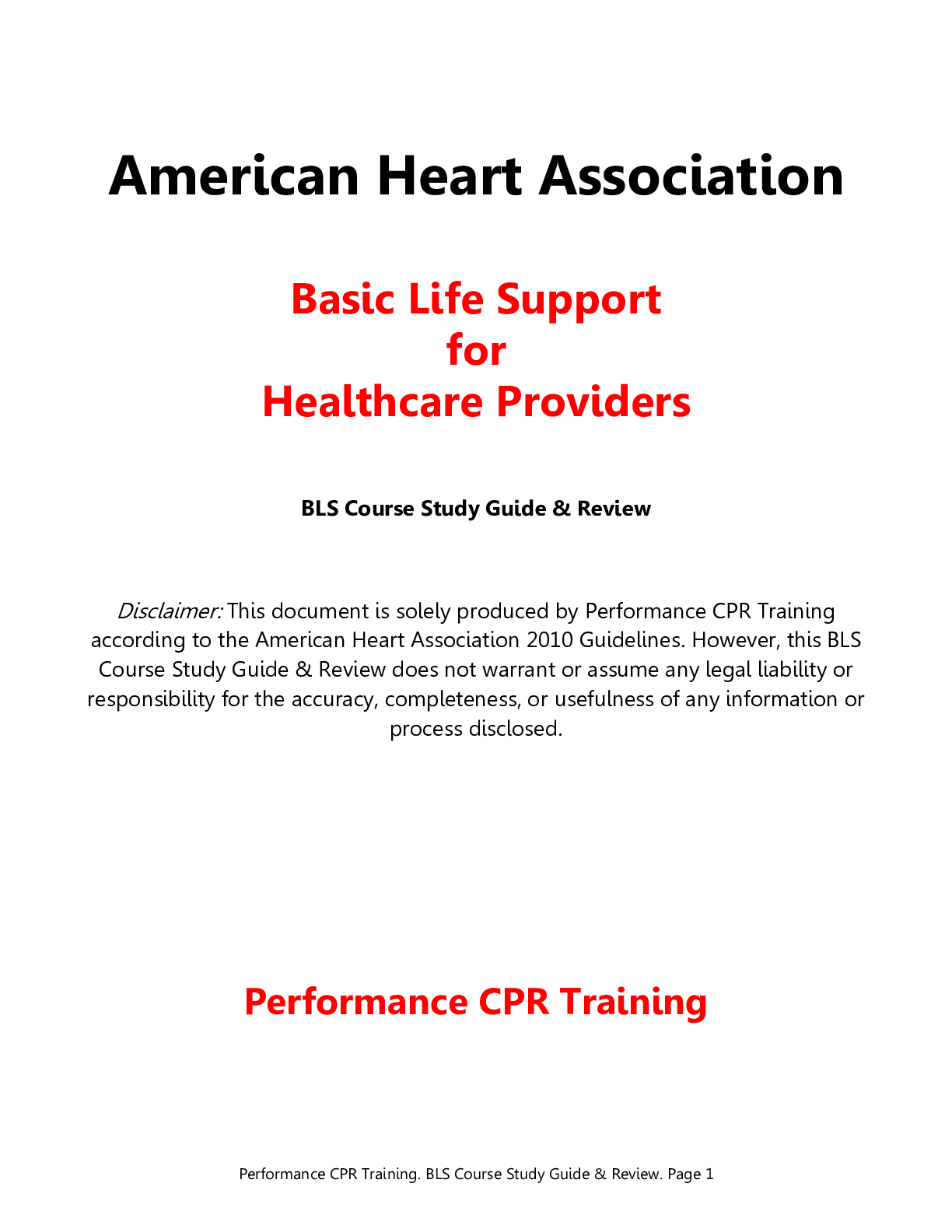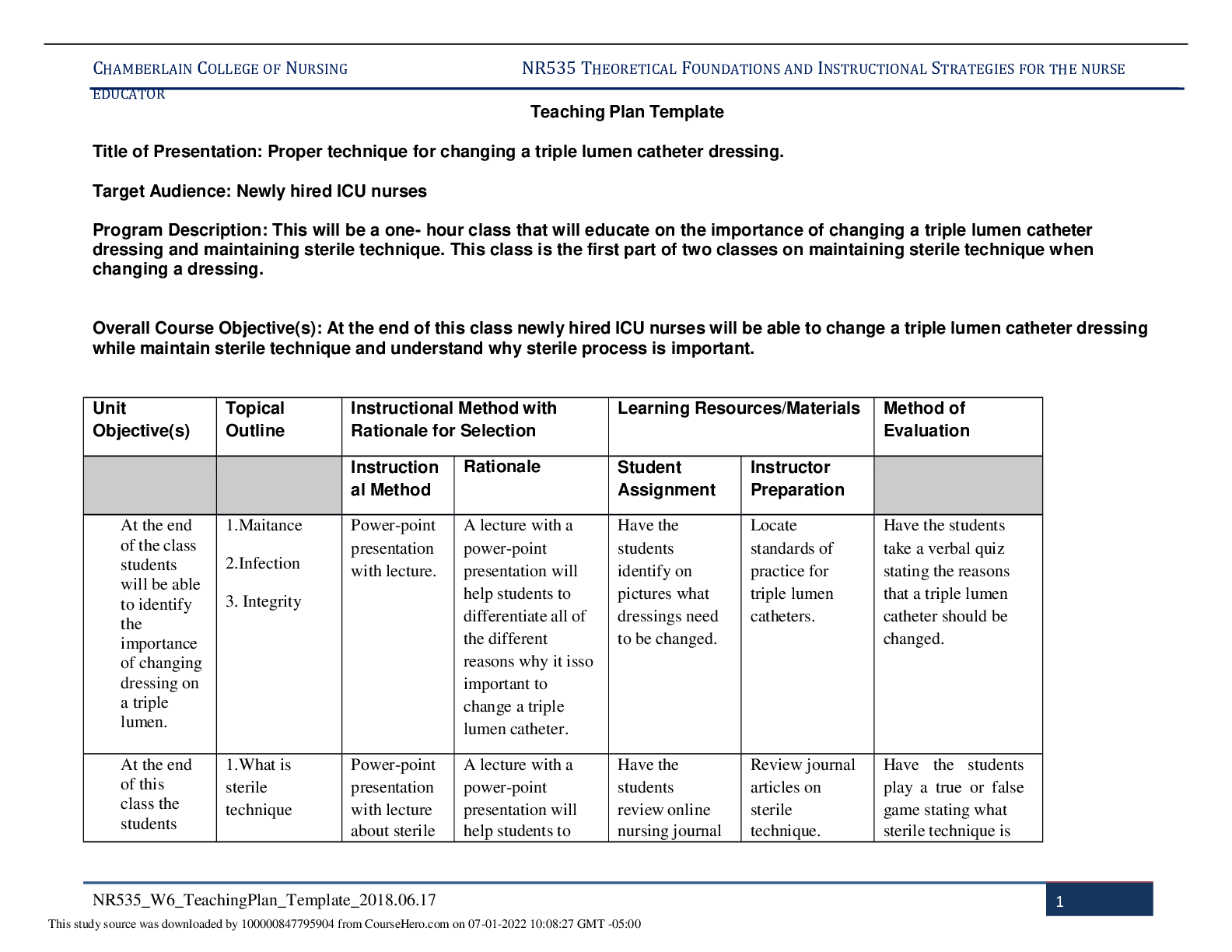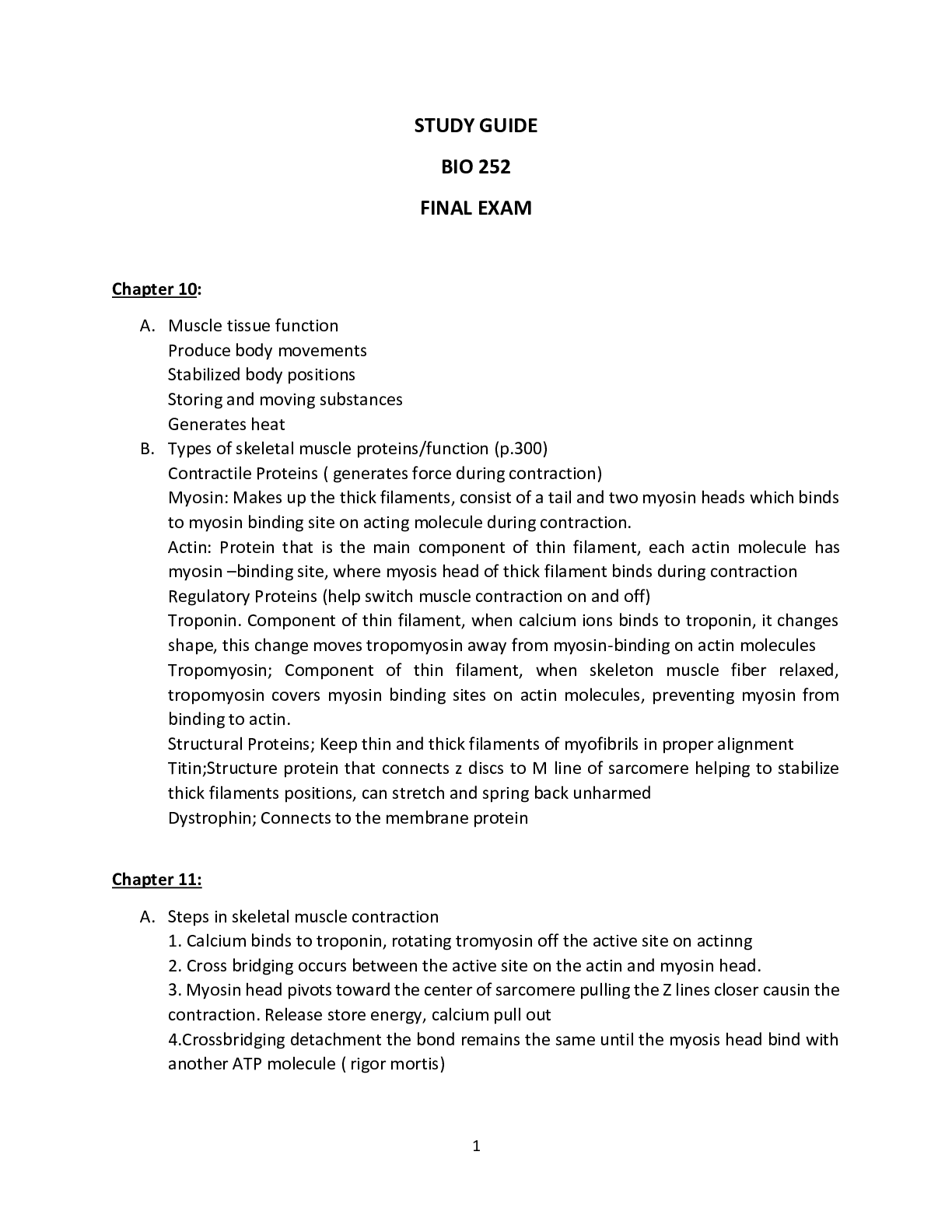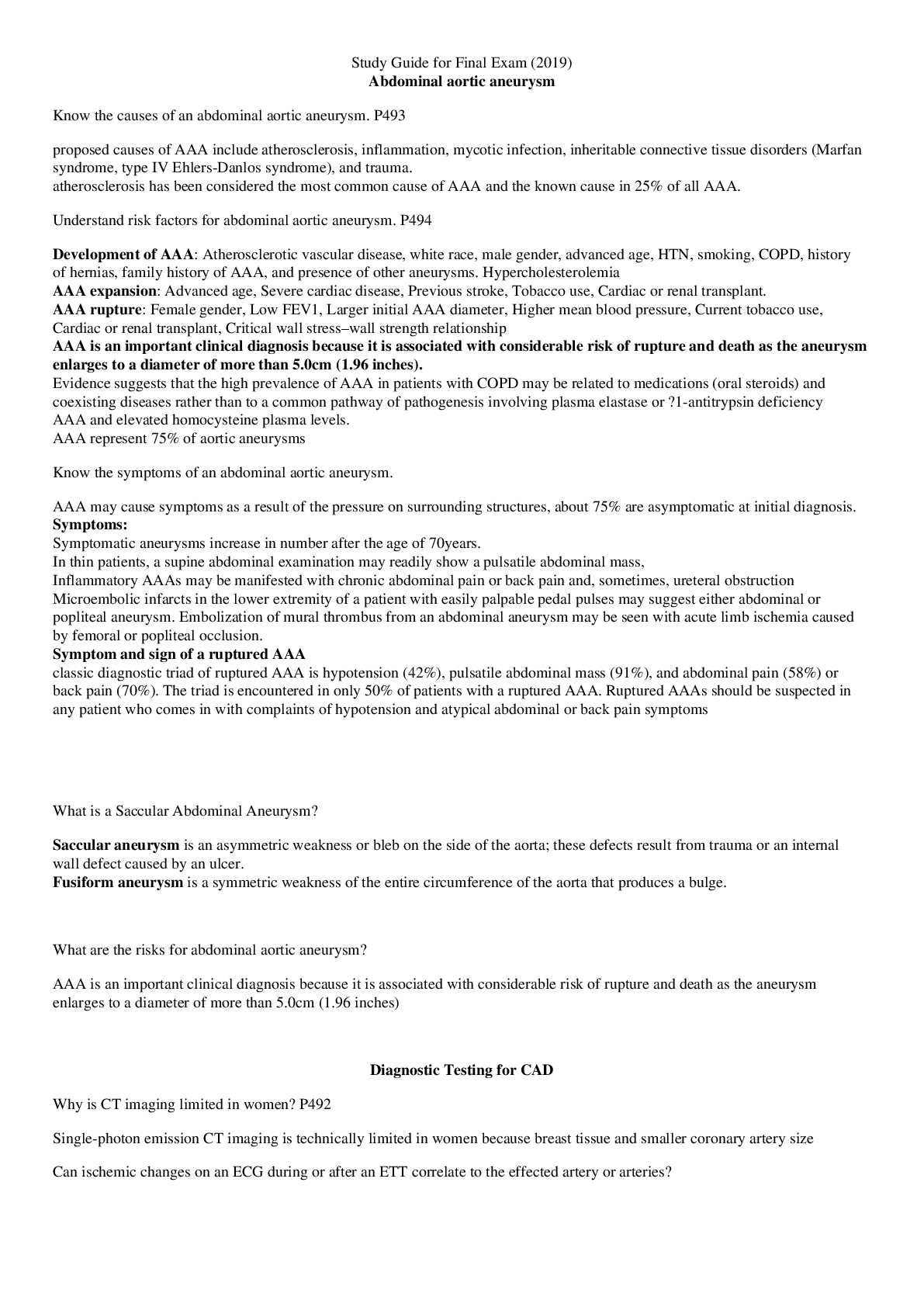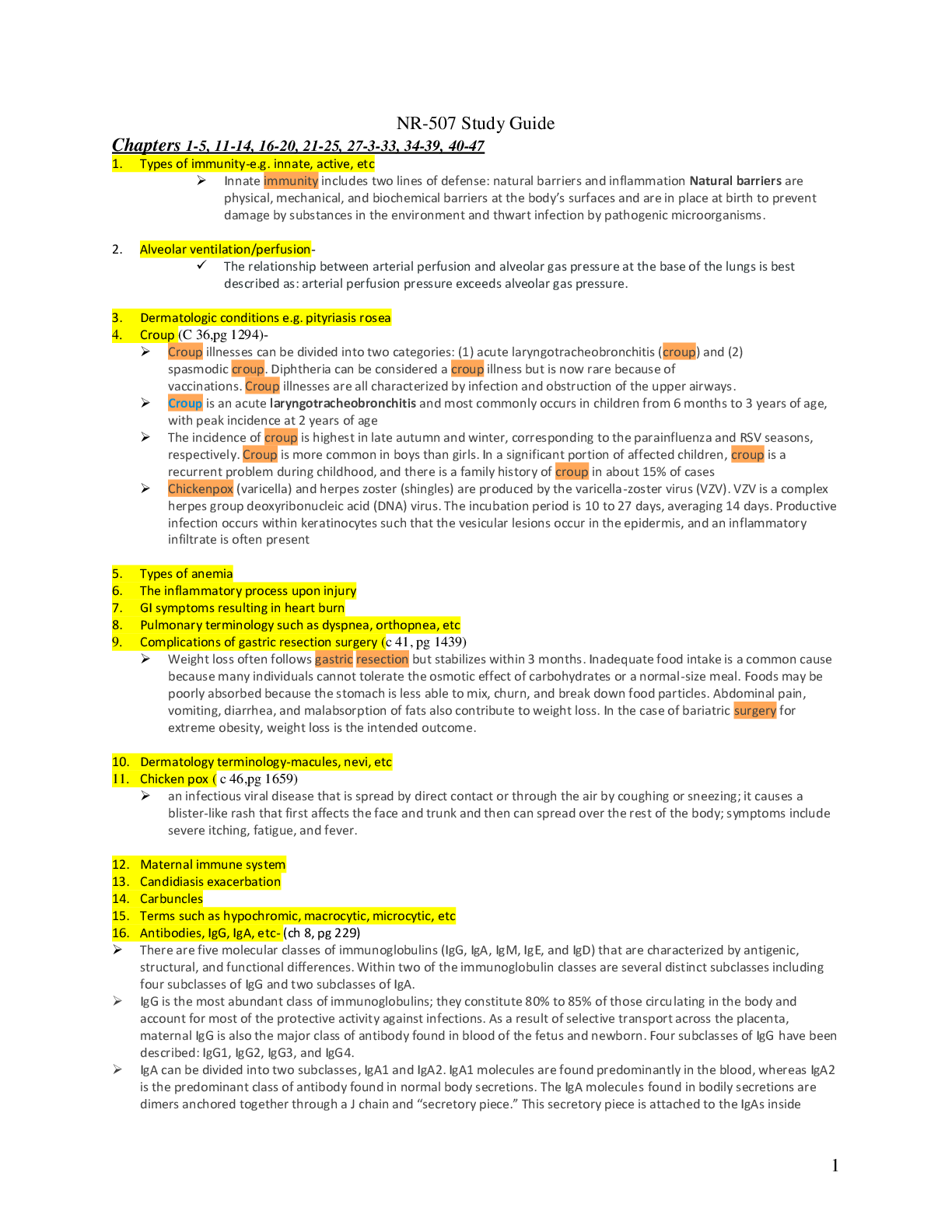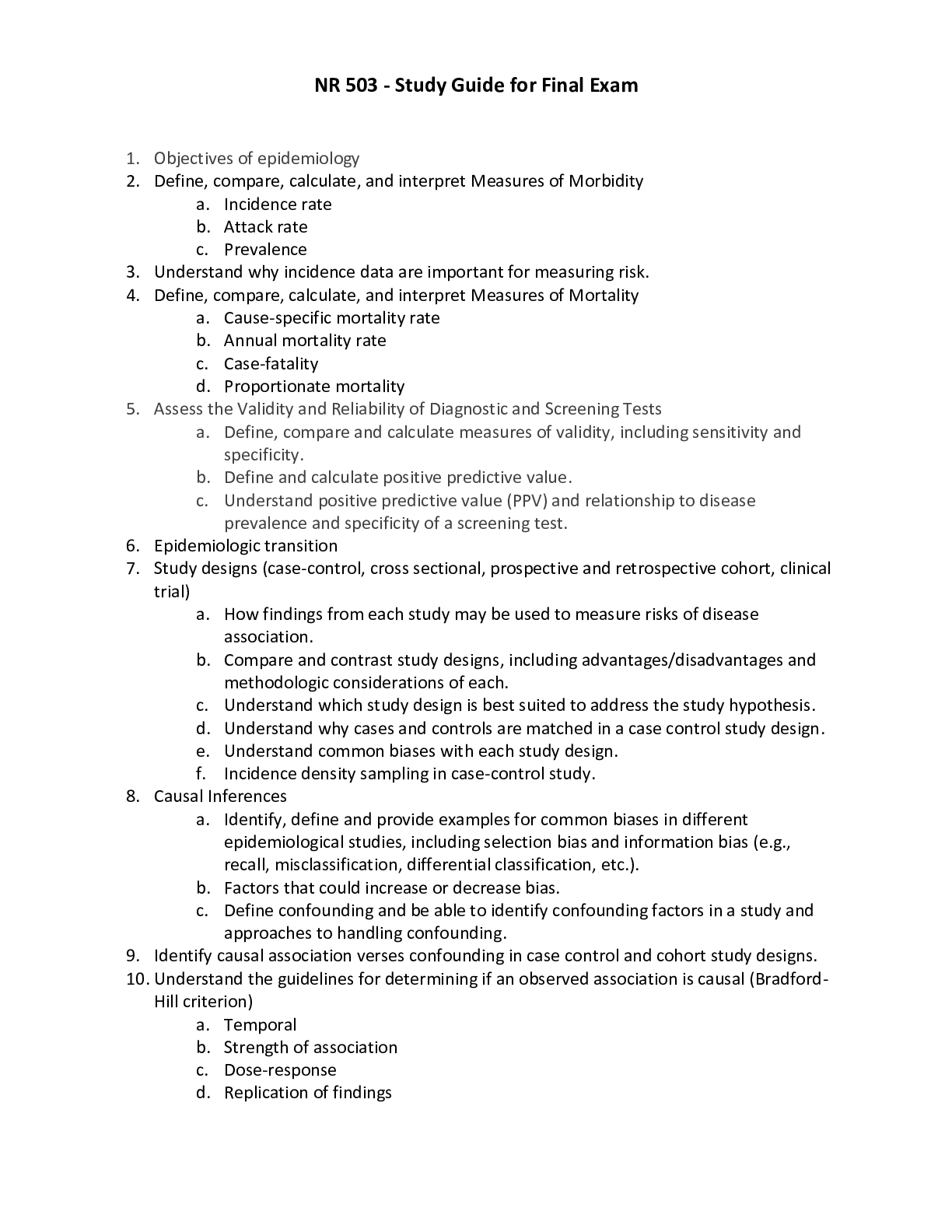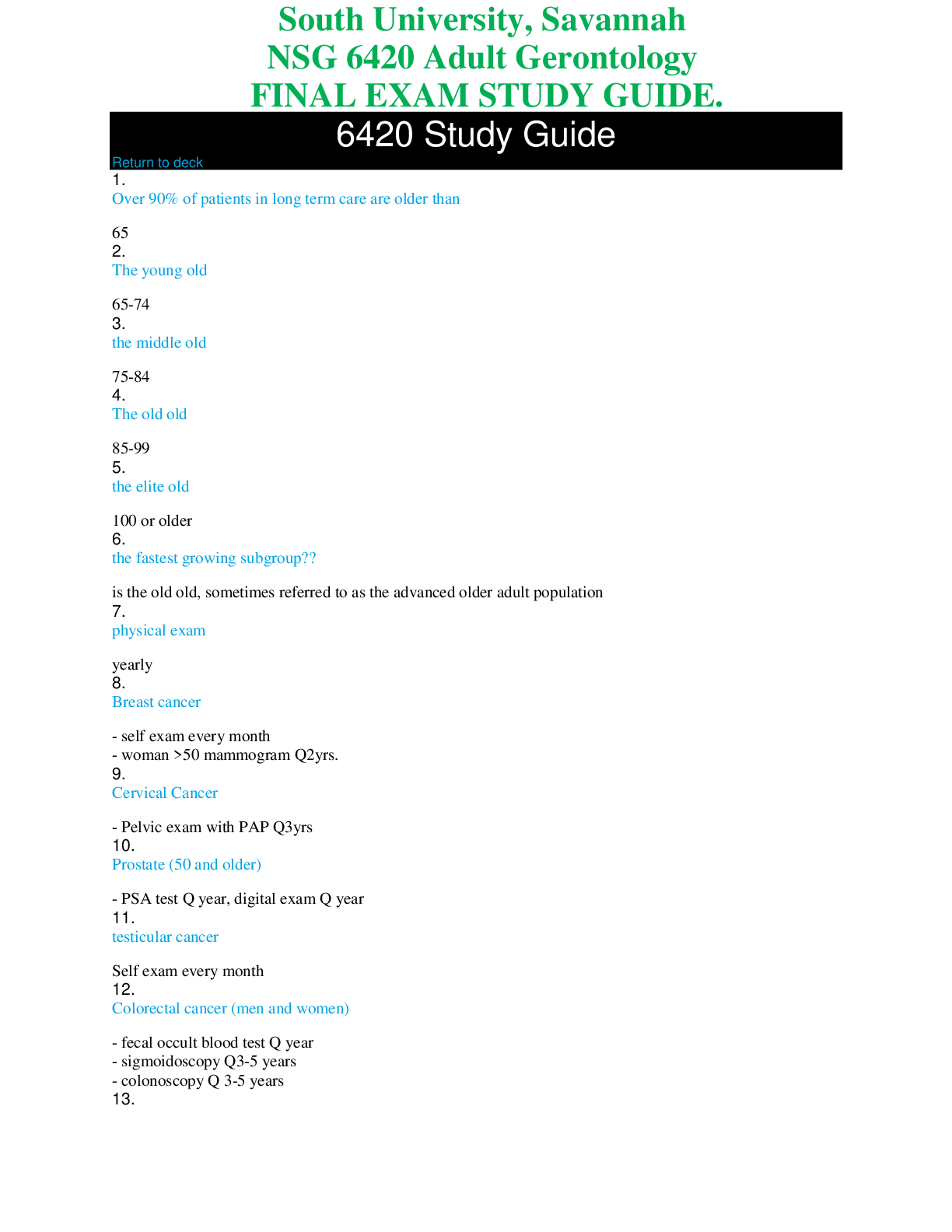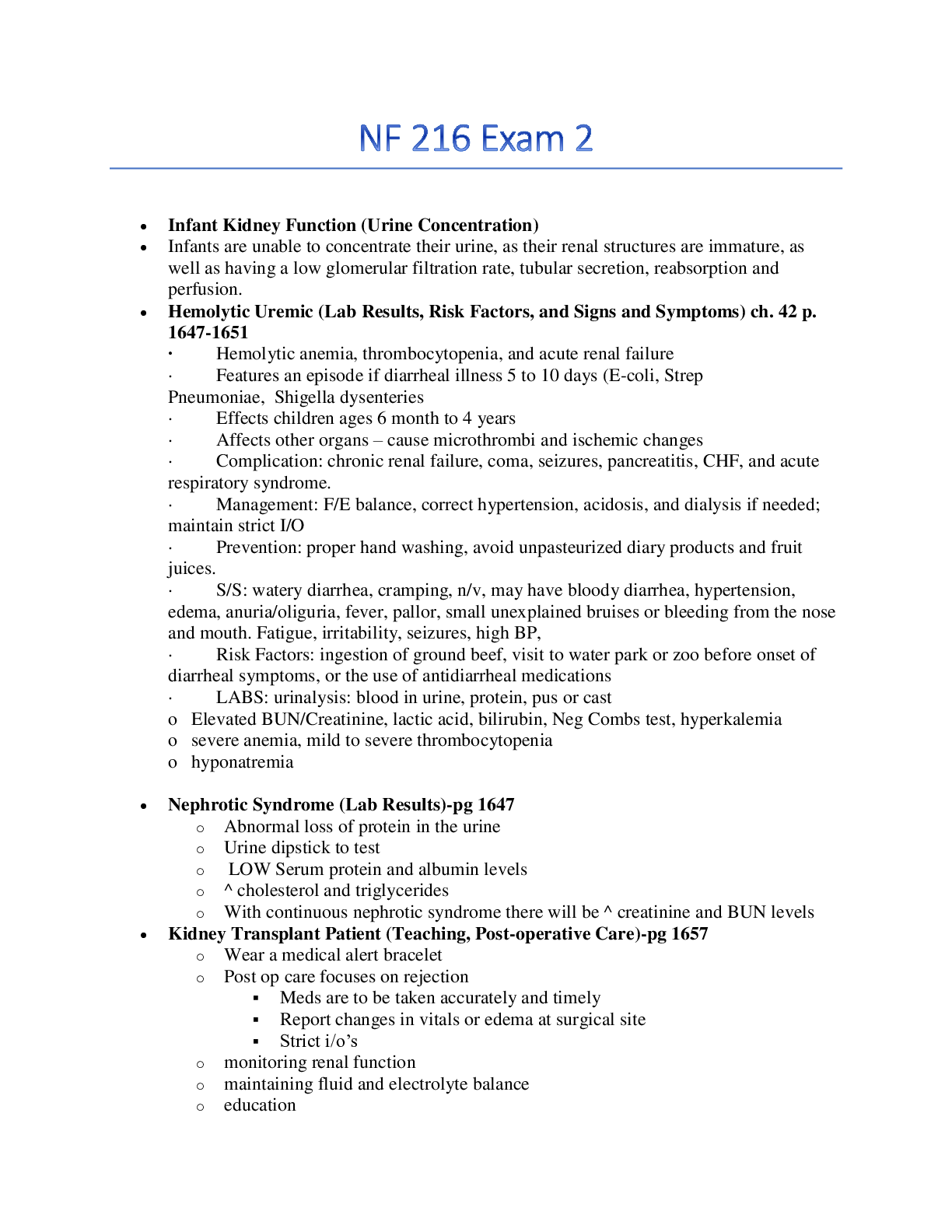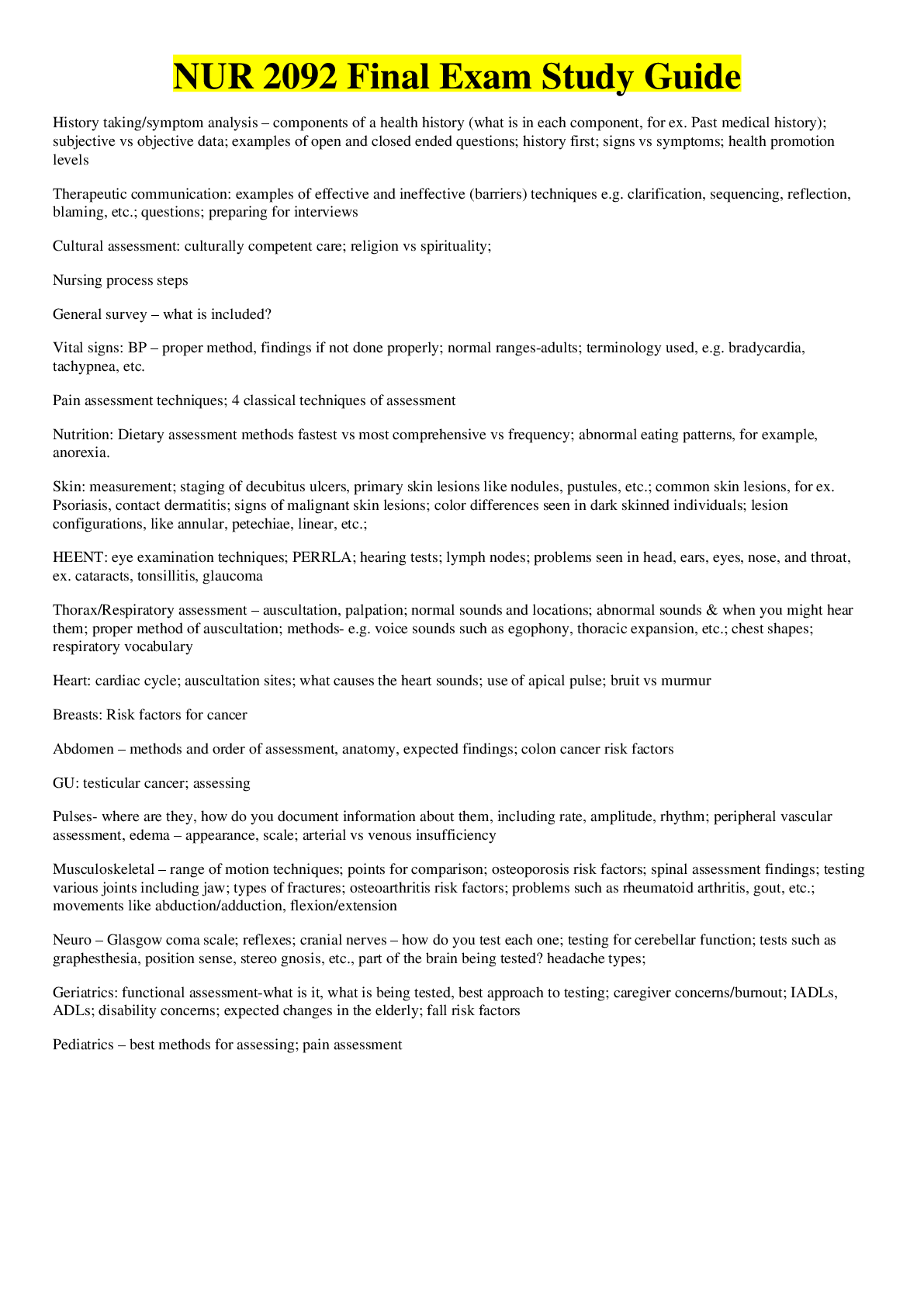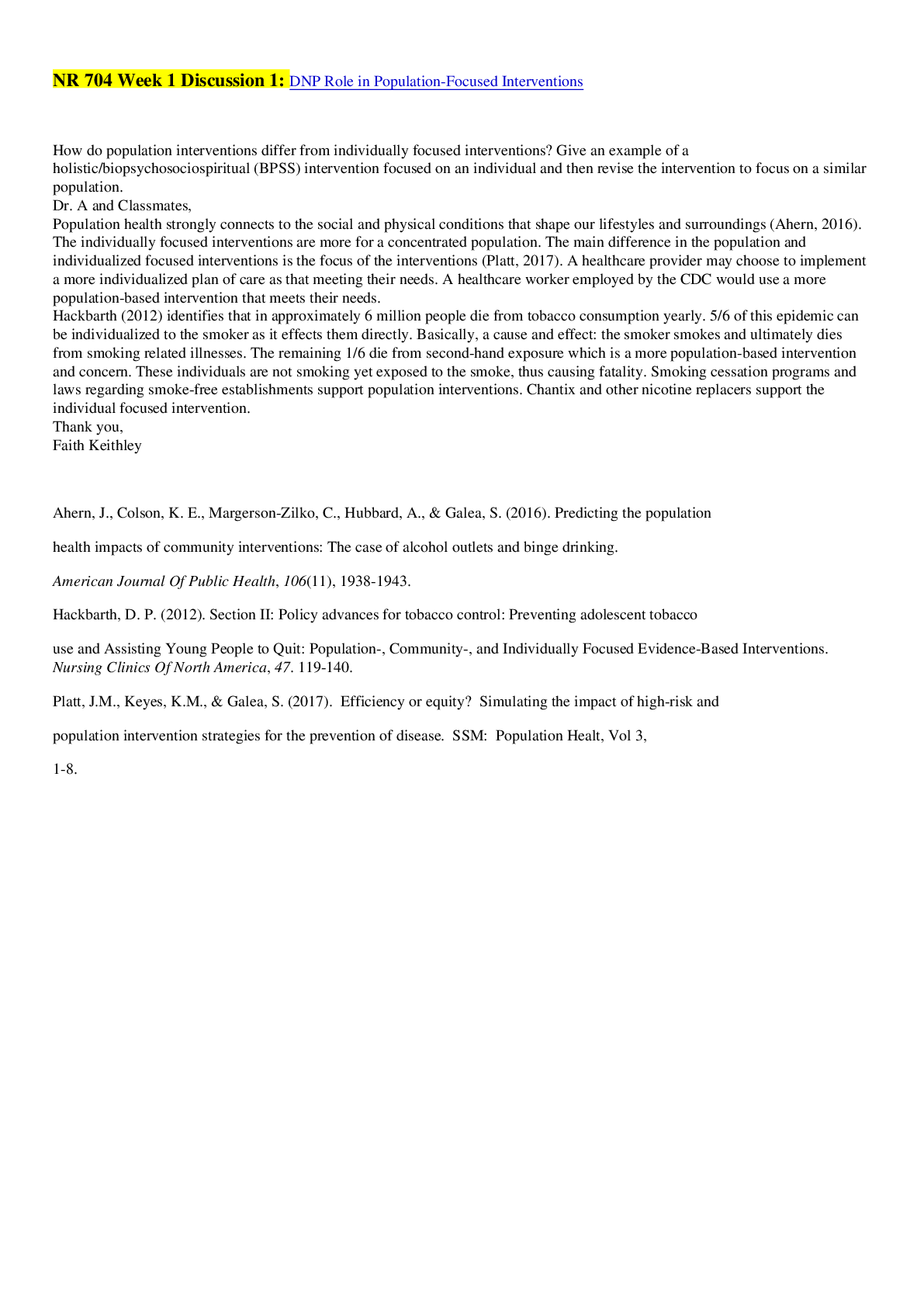*NURSING > STUDY GUIDE > NUR 112 Final Exam Study Guide (most tested questions) | Download To Score An A (All)
NUR 112 Final Exam Study Guide (most tested questions) | Download To Score An A
Document Content and Description Below
1. A student nurse is assessing the peripheral vascular system of an older adult. What action by the student would cause the faculty member to intervene? a. Assessing blood pressure in both upper ext... remities b. Auscultating the carotid arteries for any bruits c. Classifying capillary refill of 4 seconds as normal d. Palpating both carotid arteries at the same time 2. The nurse is reviewing the lipid panel of a male client who has atherosclerosis. Which finding is most concerning? a. Cholesterol: 126 mg/dL b. High-density lipoprotein cholesterol (HDL-C): 48 mg/dL c. Low-density lipoprotein cholesterol (LDL-C): 122 mg/dL d. Triglycerides: 198 mg/dL 3. The nurse is evaluating a 3-day diet history with a client who has an elevated lipid panel. What meal selection indicates the client is managing this condition well with diet? a. A 4-ounce steak, French fries, iceberg lettuce b. Baked chicken breast, broccoli, tomatoes c. Fried catfish, cornbread, peas d. Spaghetti with meat sauce, garlic bread 4. A client has been diagnosed with hypertension but does not take the antihypertensive medications because of a lack of symptoms. What response by the nurse is best? a. “Do you have trouble affording your medications?” b. “Most People with hypertension do not have symptoms.” c. “You are lucky; most people get severe morning headaches.” d. “You need to take your medicine or you will get kidney failure.” 5. A nurse is interest in providing community education and screening on hypertension. In order to reach a priority population, to what target audience should the nurse provide this service? a. African-American churches b. Asian-American groceries c. High school sports camps d. Women’s health clinics 6. The nurse is caring for four hypertensive clients. Which drug-laboratory value combination should the nurse report immediately to the health care provider? a. Furosemide (Lasix)/potassium: 2.1 mEq/L b. Hydrochlorothiazide (Hydrodiuril)/potassium: 4.2 mEq/L c. Spironolactone (Aldactone)/potassium: 5.1 mEq/L d. Torsemide (Demadex)/sodium: 142 mEq/L 7. A nurse is assessing a client with peripheral artery disease (PAD). The client states walking five blocks is possible without pain. What question asked next by the nurse will give the best information? a. “Could you walk further than that a few months ago?” b. “Do you walk mostly uphill, downhill, or on flat surfaces?” c. “Have you ever considered swimming instead of walking?” d. “How much pain medication do you take each day?” 8. A nurse is caring for four clients. Which one should the nurse see first? a. Client who needs a beta blocker, and has a blood pressure of 92/58 mm Hg b. Client who had a first dose of captopril (Capoten) and needs to use the bathroom c. Hypertensive client with a blood pressure of 188/92 mm Hg d. Client who needs pain medication prior to a dressing change of a surgical wound 9. A client had a percutaneous transluminal coronary angioplasty for peripheral arterial disease. What assessment finding by the nurse indicates a priority outcome for this client has been met? a. Pain rated as 2/10 after medication b. Distal pulse on affected extremity 2+/4+ c. Remains on bedrest as directed d. Verbalizes understanding of procedure 10. a client has a deep vein thrombosis (DVT). What comfort measure does the nurse delegate to the unlicensed assistive personnel (UAP)? a. Ambulate the client. b. Apply a warm moist pack. c. Massage the client’s leg. d. Provide an ice pack. 11. A client has been diagnosed with a deep vein thrombosis and is to be discharged on warfarin (Coumadin). The client is adamant about refusing the drug because “it’s dangerous.” What action by the nurse is best? a. Assess the reason behind the client’s fear. b. Remind the client about laboratory monitoring. c. Tell the client drugs are safer today than before. d. Warn the client about consequences of noncompliance. 12. A client has peripheral arterial disease (PAD). What statement by the client indicates misunderstanding about self-management activities? a. “I can use a heating pad on my legs if it’s set on low.” b. “I should not cross my legs when sitting or lying down.” c. “I will go out and buy some warm, heavy socks to wear.” d. “It’s going to be really hard but I will stop smoking.” 13. A client is being discharged on warfarin (Coumadin) therapy. What discharge instructions is the nurse required to provide? (Select all that apply) a. Dietary restrictions b. Driving restrictions c. Follow-up laboratory monitoring d. Possible drug-drug interactions e. Reason to take medications 14. A nurse assesses a client in an outpatient clinic. Which statement alerts the nurse to the possibility of left-sided heart failure? a. “I have been drinking more water than usual.” b. “I am awakened by the need to urinate at night.” c. “I must stop halfway up the stairs to catch my breath.” d. “I have experienced blurred vision on several occasions.” 15. A nurse assesses a client admitted to the cardiac unit. Which statement by the client alerts the nurse to the possibility of right-sided heart failure? a. “I sleep with four pillows at night.” b. “My shoes fit really tight lately.” c. “I wake up coughing every night.” d. “I have trouble catching my breath.” 16. A nurse cares for a client with right-sided heart failure. The client asks, “Why do I need to weigh myself every day?” How should the nurse respond? a. “Weight is the best indication that you are gaining or losing fluid.” b. “Daily weights will help us make sure that you’re eating properly.” c. “The hospital requires that all inpatients by weighed daily.” d. “You need to lose weight to decrease the incidence of heart failure.” 17. After administering newly prescribed captopril (Capoten) to a client with heart failure, the nurse implements interventions to decrease complications. Which priority intervention should the nurse implement for this client? a. Provide food to decrease nausea and aid in absorption. b. Instruct the client to ask for assistance when rising from bed. c. Collaborate with unlicensed assistive personnel to bathe the client. d. Monitor potassium levels and check for symptoms of hypokalemia. 18. A nurse teaches a client who is prescribed digoxin (Lanoxin) therapy. Which statement should the nurse include in this client’s teaching? a. “Avoid taking aspirin or aspirin-containing products.” b. “Increase your intake of foods that are high in potassium.” c. “Hold this medication if your pulse rate is below 80 beats/min.” d. “Do not take this medication within 1 hour of taking an antacid.” 19. A nurse admits a client who is experiencing an exacerbation of heart failure. Which action should the nurse take first? a. Assess the client’s respiratory status. b. Draw blood to assess the client’s serum electrolytes. c. Administer intravenous furosemide (Lasix). d. Ask the client about current medications. 20. A nurse assesses a client who has a history of heart failure. Which question should the nurse ask to assess the extent of the client’s heart failure” a. “Do you have trouble breathing or chest pain?” b. “Are you able to walk upstairs without fatigue?” c. “Do you awake with breathlessness during the night?” d. “Do you have new-onset heaviness in your legs?” 21. After teaching a client with diverticular disease, a nurse assesses the client’s understanding. Which menu selection made by the client indicates the client correctly understood the teaching? a. Roasted chicken with rice pilaf and a cup of coffee with cream b. Spaghetti with meat sauce, a fresh fruit cup, and hot tea c. Garden salad with a cup of bean soup and a glass of low-fat milk d. Baked fish with steamed carrots and a glass of apple juice 22. A nurse cares for a client who is prescribed mesalamine (Asacol) for ulcerative colitis. The client states, “I am having trouble swallowing this pill.” Which action should the nurse take? a. Contact the clinical pharmacist and request the medication in suspension form b. Empty the contents of the capsule into applesauce or pudding for administration. c. Ask the health care provider to prescribe the medication as an enema instead. d. Crush the pill carefully and administer it in applesauce or pudding. 23. A nurse assesses a client who has ulcerative colitis and severe diarrhea. Which assessment should the nurse complete first? a. Inspection of oral mucosa b. Recent dietary intake c. Heart rate and rhythm d. Percussion of abdomen 24. A nurse assesses a client with Crohn’s disease and colonic strictures. Which clinical manifestation should alert the nurse to urgently contact the health care provider? a. Distended abdomen b. Temperature of 100.0° F (37.8° C) c. Loose and bloody stool d. Lower abdominal cramps 25. A nurse reviews the chart of a client who has Crohn’s disease and a draining fistula. Which documentation should alert the nurse to urgently contact the provider for additional prescriptions? a. Serum potassium of 2.6 mEq/L b. Client ate 20% of breakfast meal c. White blood cell count of 8200/mm3 d. Client’s weight decreased by 3 pounds 26. A nurse cares for a client with ulcerative colitis. The client states, “I feel like I am tied to the toilet. This disease is controlling my life.” How should the nurse respond? a. “Let’s discuss potential factors that increase your symptoms.” b. “If you take the prescribed medications, you will no longer have diarrhea.” c. “To decrease distress, do not eat anything before you go out.” d. “You must retake control of your life. I will consult a therapist to help.” 27. A nurse assesses a client with peritonitis. Which clinical manifestations should the nurse expect to find? (Select all that apply.) a. Distended abdomen b. Inability to pass flatus c. Bradycardia d. Hyperactive bowel sounds e. Decreased urine output 28. A nurse assesses a client after administering a prescribed beta blocker. Which assessment should the nurse expect to find? a. Blood pressure increased from 98/42 mm Hg to 132/60 mm Hg b. Respiratory rate decreased from 25 breaths/min to 14 breaths/min c. Oxygen saturation increased from 88% to 96% d. Pulse decreased from 100 beats/min to 80 beats/min 29. An emergency room nurse obtains the health history of a client. Which statement by the client should alert the nurse to the occurrence of heart failure? a. “I get short of breath when I climb stairs.” b. “I see halos floating around my head.” c. “I have trouble remembering things.” d. “I have lost weight over the past month.” 30. A nurse obtains the health history of a client who is newly admitted to the medical unit. Which statement by the client should alert the nurse to the presence of edema? a. “I wake up to go to the bathroom at night.” b. “My shoes fit tighter by the end of the day.” c. “I seem to be feeling more anxious lately.” d. “I drink at least eight glasses of water a day.” 31. A nurse educator is teaching a urology unit to a group of nursing students. The educator is reviewing risk factors for the diagnosis of benign prostatic hyperplasia (BPH). The educator includes which risk factor to the group? Select all that apply. a. Excessive exercise b. Diet high in meat and fats c. Diet high in milk d. Age e. Race 32. The nurse is triaging a client who present to the to the urgent care clinic with symptoms of severe flank pain with spasms, nausea, vomiting, and oliguria. The client states that the pain was initially intermittent and radiated from the lower back to the lower quadrants of the abdomen. What should the nurse do next? a. Complete the physical assessment. b. Refer the client to a urologist immediately. c. Instruct the client to increase fluids. d. Obtain a urine specimen for culture. 33. A graduate nurse has joined the staff in the care of renal clients. The graduate asks the preceptor what puts a client at risk urinary calculi. The nurse identifies which client as having the greatest risk for urinary stones? a. A 35-year-old female with quadriplegia from an auto accident. b. A 65-year-old male with a recent history of myocardial infarction c. A 50-year-old male with type II diabetes mellitus d. A 25-year-old female with several episodes of urinary infection 34. A client with coronary artery disease (CAD) asks the nurse about taking fish oil supplements. What response by the nurse is best? a. “Fish oil is contraindicated with most drugs for CAD.” b. “The best source is fish, but pills have benefits too.” c. “There is no evidence to support fish oil use with CAD.” d. “You can reverse CAD totally with diet and supplements.” 35. A nurse cares for a client who states, “My husband is repulsed by my colostomy and refuses to be intimate with me.” How should the nurse respond? a. “Let’s talk to the ostomy nurse to help you and your husband work through this.” b. “You could try to wear longer lingerie that will better hide the ostomy appliance.” c. “You should empty the pouch first so it will be less noticeable for your husband.” d. “If you are not careful, you can hurt the stoma if you engage in sexual activity.” 36. A nurse assesses a client who is prescribed 5-fluorouracil (5-FU) chemotherapy intravenously for the treatment of colon cancer. Which assessment finding should alert the nurse to contact the health care provider? a. White blood cell (WBC) count of 1500/mm3 b. Fatigue c. Nausea and diarrhea d. Mucositis and oral ulcers 37. A nurse cares for a client who had a colostomy placed in the ascending colon 2 weeks ago. The client states, “The stool in my pouch is still liquid.” How should the nurse respond? a. “The stool will always be liquid with this type of colostomy.” b. “Eating additional fiber will bulk up your stool and decrease diarrhea.” c. “Your stool will become firmer over the next couple of weeks.” d. “This is abnormal. I will contact your health care provider.” 38. A nurse teaches a client who is at risk for colon cancer. Which dietary recommendation should the nurse teach this client? a. “Eat low-fiber and low-residual foods.” b. “White rice and bread are easier to digest.” c. “Add vegetables such as broccoli and cauliflower to your new diet.” d. “Foods high in animal fat help to protect the intestinal mucosa.” 39. A nurse cares for a client who has a new colostomy. Which action should the nurse take? a. Empty the pouch frequently to remove excess gas collection. b. Change the ostomy pouch and wafer every morning. c. Allow the pouch to completely fill with stool prior to emptying it. d. Use surgical tape to secure the pouch and prevent leakage. 40. A nurse teaches a client about self-monitoring of blood glucose levels. Which statement should the nurse include in this client’s teaching to prevent bloodborne infections? a. “Wash your hands after completing each test.” b. “Do not share your monitoring equipment.” c. “Blot excess blood from the strip with a cotton ball.” d. “Use gloves when monitoring your blood glucose.” 41. A nurse teaches a client with type 2 diabetes mellitus who is prescribed glipizide (Glucotrol). Which statement should the nurse include in this client’s teaching? a. “Change positions slowly when you get out of bed.” b. “Avoid taking nonsteroidal anti-inflammatory drugs (NSAIDs).” c. “If you miss a dose of this drug, you can double the next dose.” d. “Discontinue the medication if you develop a urinary infection.” 42. After teaching a client with diabetes mellitus to inject insulin, the nurse assesses the client’s understanding. Which statement made by the client indicates a need for additional teaching? a. “The lower abdomen is the best location because it is closest to the pancreas.” b. “I can reach my thigh the best, so I will use the different areas of my thighs.” c. “By rotating the sites in one area, my chance of having a reaction is decreased.” d. “Changing injection sites from the thigh to the arm will change absorption rates.” 43. An emergency department nurse assesses a client with ketoacidosis. Which clinical manifestation should the nurse correlate with this condition? a. Increased rate and depth of respiration b. Extremity tremors followed by seizure activity c. Oral temperature of 102° F (38.9° C) d. Severe orthostatic hypotension 44. After teaching a client who is recovering from pancreas transplantation, the nurse assesses the client’s understanding. Which statement made by the client indicates a need for additional education? a. “If I develop an infection, I should stop taking my corticosteroid.” b. “If I have pain over the transplant site, I will call the surgeon immediately.” c. “I should avoid people who are ill or who have an infection.” d. “I should take my cyclosporine exactly the way I was taught.” 45. A nurse reviews the laboratory results of a client who is receiving intravenous insulin. Which should alert the nurse to intervene immediately? a. Serum chloride level of 98 mmol/L b. Serum calcium level of 8.8 mg/dL c. Serum sodium level of 132 mmol/L d. Serum potassium level of 2.5 mmol/L 46. A nurse cares for a client who has diabetes mellitus. The nurse administers 6 units of regular insulin and 10 units of NPH insulin at 0700. At which time should the nurse assess the client for potential problems related to the NPH insulin? a. 0800 b. 1600 c. 2000 d. 2300 47. A nurse reviews the medication list of a client recovering from a computed tomography (CT) scan with IV contrast to rule out small bowel obstruction. Which medication should alert the nurse to contact the provider and withhold the prescribed dose? a. Pioglitazone (Actos) b. Glimepiride (Amaryl) c. Glipizide (Glucotrol) d. Metformin (Glucophage) 48. A nurse prepares to administer insulin to a client at 1800. The client’s medication administration record contains the following information: • Insulin glargine: 12 units daily at 1800 • Regular insulin: 6 units QID at 0600, 1200, 1800, 2400 Based on the client’s medication administration record, which action should the nurse take? a. Draw up and inject the insulin glargine first, and then draw up and inject the regular insulin. b. Draw up and inject the insulin glargine first, wait 20 minutes, and then draw up and inject the regular insulin. c. First draw up the dose of regular insulin, then draw up the dose of insulin glargine in the same syringe, mix, and inject the two insulins together. d. First draw up the dose of insulin glargine, then draw up the dose of regular insulin in the same syringe, mix, and inject the two insulins together. 49. A nurse prepares to administer prescribed regular and NPH insulin. Place the nurse’s actions in the correct order to administer these medications. 1. Inspect bottles for expiration dates. 2. Gently roll the bottle of NPH between the hands. 3. Wash your hands. 4. Inject air into the regular insulin. 5. Withdraw the NPH insulin. 6. Withdraw the regular insulin. 7. Inject air into the NPH bottle. 8. Clean rubber stoppers with an alcohol swab. a. 1, 3, 8, 2, 4, 6, 7, 5 b. 3, 1, 2, 8, 7, 4, 6, 5 c. 8, 1, 3, 2, 4, 6, 7, 5 d. 2, 3, 1, 8, 7, 5, 4, 6 50. A nurse assesses a client who is experiencing diabetic ketoacidosis (DKA). For which manifestations should the nurse monitor the client? (Select all that apply.) a. Deep and fast respirations b. Decreased urine output c. Tachycardia d. Dependent pulmonary crackles e. Orthostatic hypotension 51. A client just returned to the surgical unit after a gastric bypass. What action by the nurse is the priority? a. Assess the client’s pain. b. Check the surgical incision. c. Ensure an adequate airway. d. Program the morphine pump. 52. A client is receiving total parenteral nutrition (TPN). What action by the nurse is most important? a. Assessing blood glucose as directed b. Changing the IV dressing each day c. Checking the TPN with another nurse d. Performing appropriate hand hygiene 53. An older female client with hyperthyroidism is not a candidate for surgery. Which treatment could be used to quickly reduce the client’s manifestations of the disorder? a. Nothing, because there is little effect on the quality of life in older adults. b. A partial thyroidectomy c. The ingestion of radioactive sodium iodine, I131 d. A combination treatment with levothyroid (Synthroid) and amiodarone (Cordarone) 54. The healthcare provider prescribed sitagliptin (Januvia) for a client with type 2 diabetes mellitus. For which potential side effect should the nurse monitor in this client? a. Elevated blood lipid levels b. Hyperglycemia c. Pancreatitis d. Renal insufficiency 55. A nurse witnesses a client begin to experience a tonic-clonic seizure and loss of consciousness. Which action should the nurse take? a. Start fluids via a large-bore catheter. b. Turn the client’s head to the side. c. Administer IV push diazepam. d. Prepare to intubate the client. 56. After teaching a client newly diagnosed with epilepsy, the nurse assesses the client’s understanding. Which statement by the client indicates a need for additional teaching? a. “I will wear my medical alert bracelet at all times.” b. “While taking my epilepsy medications, I will not drink any alcoholic beverages.” c. “I will tell my doctor about my prescription and over-the-counter medications.” d. “If I am nauseated, I will not take my epilepsy medication.” 57. A nurse obtains a focused health history for a client who is suspected of having bacterial meningitis. Which question should the nurse ask? a. “Do you live in a crowded residence?” b. “When was your last tetanus vaccination?” c. “Have you had any viral infections recently?” d. “Have you traveled out of the country in the last month?” 58. A nurse plans care for a client with epilepsy who is admitted to the hospital. Which interventions should the nurse include in this client’s plan of care? (Select all that apply.) a. Have suction equipment at the bedside. b. Place a padded tongue blade at the bedside. c. Permit only clear oral fluids. d. Keep bed rails up at all times. e. Maintain the client on strict bedrest. f. Ensure that the client has IV access. 59. A nurse evaluates the results of diagnostic tests on a client’s cerebrospinal fluid (CSF). Which fluid results alerts the nurse to possible viral meningitis? (Select all that apply.) a. Clear b. Cloudy c. Increased protein level d. Normal glucose level e. Bacterial organisms present f. Increased white blood cells 60. A nurse is caring for a client with meningitis. Which laboratory values should the nurse monitor to identify potential complications of this disorder? (Select all that apply.) a. Sodium level b. Liver enzymes c. Clotting factors d. Cardiac enzymes e. Creatinine level 61. A nurse assesses a client who is recovering from the implantation of a vagal nerve stimulation device. For which clinical manifestations should the nurse assess as common complications of this procedure? (Select all that apply.) a. Bleeding b. Infection c. Hoarseness d. Dysphagia e. Seizures 62. A nurse assesses a client with hyperthyroidism who is prescribed lithium carbonate. Which assessment finding should alert the nurse to a side effect of this therapy? a. Blurred and double vision b. Increased thirst and urination c. Profuse nausea and diarrhea d. Decreased attention and insomnia 63. A nurse assesses a client who is recovering from a total thyroidectomy and notes the development of stridor. Which action should the nurse take first? a. Reassure the client that the voice change is temporary. b. Document the finding and assess the client hourly. c. Place the client in High-Fowler’s position and apply oxygen. d. Contact the provider and prepare for intubation. 64. A nurse plans care for a client with hypothyroidism. Which priority problem should the nurse plan to address first for this client? a. Heat intolerance b. Body image problems c. Depression and withdrawal d. Obesity and water retention 65. A nurse assesses a client who is prescribed levothyroxine (Synthroid) for hypothyroidism. Which assessment finding should alert the nurse that the medication therapy is effective? a. Thirst is recognized and fluid intake is appropriate. b. Weight has been the same for 3 weeks. c. Total white blood cell count is 6000 cells/mm3. d. Heart rate is 70 beats/min and regular. 66. While assessing a client with Graves’ disease, the nurse notes that the client’s temperature has risen 1° F. Which action should the nurse take first? a. Turn the lights down and shut the client’s door. b. Call for an immediate electrocardiogram (ECG). c. Calculate the client’s apical-radial pulse deficit. d. Administer a dose of acetaminophen (Tylenol). 67. A nurse teaches a client with hyperthyroidism. Which dietary modifications should the nurse include in this client’s teaching? (Select all that apply.) a. Increased carbohydrates b. Decreased fats c. Increased calorie intake d. Supplemental vitamins e. Increased proteins 68. A nurse teaches a client who is prescribed an unsealed radioactive isotope. Which statements should the nurse include in this client’s education? (Select all that apply.) a. “Do not share utensils, plates, and cups with anyone else.” b. “You can play with your grandchildren for 1 hour each day.” c. “Eat foods high in vitamins such as apples, pears, and oranges.” d. “Wash your clothing separate from others in the household.” e. “Take a laxative 2 days after therapy to excrete the radiation.” 69. A nurse reads on a hospitalized client’s chart that the client is receiving teletherapy. What action by the nurse is best? a. Coordinate continuation of the therapy. b. Place the client on radiation precautions. c. No action by the nurse is needed at this time. d. Restrict visitors to only adults over age 18. 70. A new nurse has been assigned a client who is in the hospital to receive iodine-131 treatment. Which action by the nurse is best? a. Ensure the client is placed in protective isolation. b. Hand off a pregnant client to another nurse. c. No special action is necessary to care for this client. d. Read the policy on handling radioactive excreta. 71. A client tells the oncology nurse about an upcoming vacation to the beach to celebrate completing radiation treatments for cancer. What response by the nurse is most appropriate? a. “Avoid getting salt water on the radiation site.” b. “Do not expose the radiation area to direct sunlight.” c. “Have a wonderful time and enjoy your vacation!” d. “Remember you should not drink alcohol for a year.” 72. A client is receiving chemotherapy through a peripheral IV line. What action by the nurse is most important? a. Assessing the IV site every hour b. Educating the client on side effects c. Monitoring the client for nausea d. Providing warm packs for comfort 73. A client with cancer is admitted to a short-term rehabilitation facility. The nurse prepares to administer the client’s oral chemotherapy medications. What action by the nurse is most appropriate? a. Crush the medications if the client cannot swallow them. b. Give one medication at a time with a full glass of water. c. No special precautions are needed for these medications. d. Wear personal protective equipment when handling the medications. 74. After receiving the hand-off report, which client should the oncology nurse see first? a. Client who is afebrile with a heart rate of 108 beats/min b. Older client on chemotherapy with mental status changes c. Client who is neutropenic and in protective isolation d. Client scheduled for radiation therapy today 75. A client has a platelet count of 9800/mm3. What action by the nurse is most appropriate? a. Assess the client for calf pain, warmth, and redness. b. Instruct the client to call for help to get out of bed. c. Obtain cultures as per the facility’s standing policy. d. Place the client on protective isolation precautions. 76. A client hospitalized for chemotherapy has a hemoglobin of 6.1 mg/dL. What medication should the nurse prepare to administer? a. Epoetin alfa (Epogen) b. Filgrastim (Neupogen) c. Mesna (Mesnex) d. Oprelvekin (Neumega) 77. A nurse is assessing a female client who is taking progestins. What assessment finding requires the nurse to notify the provider immediately? a. Irregular menses b. Edema in the lower extremities c. Ongoing breast tenderness d. Red, warm, swollen calf 78. A nurse working with clients who experience alopecia knows that which is the best method of helping clients manage the psychosocial impact of this problem? a. Assisting the client to pre-plan for this event b. Reassuring the client that alopecia is temporary c. Teaching the client ways to protect the scalp d. Telling the client that there are worse side effects 79. A client is having a catheter placed in the femoral artery to deliver yttrium-90 beads into a liver tumor. What action by the nurse is most important? a. Assessing the client’s abdomen beforehand b. Ensuring that informed consent is on the chart c. Marking the client’s bilateral pedal pulses d. Reviewing client teaching done previously 80. A nurse works on an oncology unit and delegates personal hygiene to an unlicensed assistive personnel (UAP). What action by the UAP requires intervention from the nurse? a. Allowing a very tired client to skip oral hygiene and sleep b. Assisting clients with washing the perianal area every 12 hours c. Helping the client use a soft-bristled toothbrush for oral care d. Reminding the client to rinse the mouth with water or saline 81. A nurse teaches a client who has chronic obstructive pulmonary disease. Which statements related to nutrition should the nurse include in this client’s teaching? (Select all that apply.) a. “Avoid drinking fluids just before and during meals.” b. “Rest before meals if you have dyspnea.” c. “Have about six small meals a day.” d. “Eat high-fiber foods to promote gastric emptying.” e. “Increase carbohydrate intake for energy.” 82. After providing discharge teaching, a nurse assesses the client’s understanding regarding increased risk for metabolic alkalosis. Which statement indicates the client needs additional teaching? a. “I don’t drink milk because it gives me gas and diarrhea.” b. “I have been taking digoxin every day for the last 15 years.” c. “I take sodium bicarbonate after every meal to prevent heartburn.” d. “In hot weather, I sweat so much that I drink six glasses of water each day.” 83. The nurse caring for a client newly diagnosed with asthma is developing the client’s plan of care. Which intervention would be most appropriate for the nurse to include in the plan of care if the nurse wants to promote airway clearance? a. Provide adequate rest periods. b. Reduce excessive stimuli. c. Assist with ADLs. d. Place in Fowler position. 84. The mother of a 5-month-old baby is concerned because the child has developed a runny nose, cough, and low-grade fever over the last few days. What do these signs suggest to the nurse? a. Meningitis b. Respiratory syncytial virus (RSV) bronchiolitis c. Bronchitis d. The common cold 85. The mother of an 8-month-old baby who has developed respiratory syncytial virus (RSV)/bronchiolitis wants to know what factors contribute to the risk of contracting RSV. What can the nurse tell this mother? a. “There is a higher risk in children who are being breastfed.” b. “There is no way to avoid the illness.” c. “There is a higher risk in children who are exposed to secondary cigarette smoke.” d. “It is seen more frequently in children who do not attend daycare.” 86. The nurse observes a young child, admitted with possible respiratory syncytial virus (RSV) bronchiolitis, grunting with expiration. What should the nurse do to assist this child? a. Assist the child to clear the nasal passages. b. Limit fluids. c. Suction the airway to relieve the obstruction. d. Lay the child on his back. 87. A child with respiratory syncytial virus (RSV) bronchiolitis is prescribed intubation to maintain an adequate airway. The nurse will collaborate on the care of this client with. Select all that apply. a. An advanced practice nurse. b. A dietitian. c. The primary care physician d. A respiratory therapist. e. Anesthesiologist [Show More]
Last updated: 1 year ago
Preview 1 out of 12 pages
Instant download
 (1).png)
Buy this document to get the full access instantly
Instant Download Access after purchase
Add to cartInstant download
Reviews( 0 )
Document information
Connected school, study & course
About the document
Uploaded On
Mar 13, 2022
Number of pages
12
Written in
Additional information
This document has been written for:
Uploaded
Mar 13, 2022
Downloads
0
Views
73



